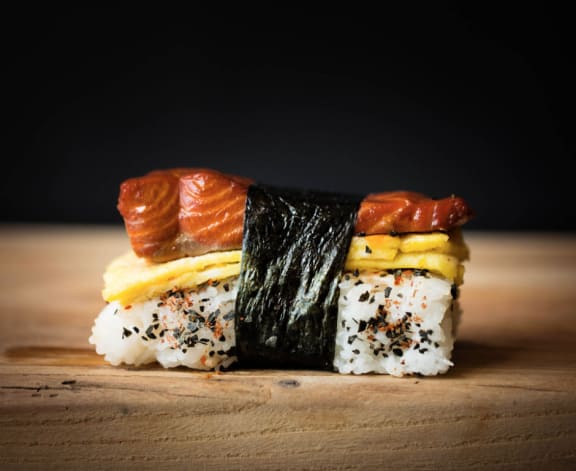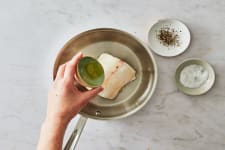Think of it as the cousin of onigiri, but with a higher fish-to-rice ratio: Salmon musubi is one par one part rice and one part wild-caught sockeye or coho, fastened together with a strip of nori into a tasty little bundle. You can enjoy salmon musubi as a hearty snack, as one part of a sack lunch, or as a light meal.
The quintessential version of musubi is an on-the-go nosh that’s widely available in Hawaii, where it’s typically made with Spam. But to give it an Alaskan kick, we use wild salmon in our interpretation.
There’s no right recipe to follow when you’re riffing on musubi at home with wild salmon. We do, however, have a few suggestions that will help you build the best musubi.
Use high-heat cooking methods to cook the salmon.
Cooking your fillet with high heat will produce a firmer piece of fish that is easier to work with when assembling musubi. Broiling is perhaps the most foolproof option, since it simply goes in and out of the oven, and all you have to keep an eye on is the kitchen timer. Don’t step away from the oven, though: Broiling musubi-sized cuts of salmon can go from perfectly browned to burnt in practically an instant. They’ll need 3 minutes maximum under the broiler element in most ovens, which is just enough time for the skin to crisp up without overcooking the fillet itself.
Alternatively, try pan-searing or grilling your musubi cuts to get a slightly different texture or flavor profile. Again, since you’re using smaller pieces of salmon, they will cook up faster than a full-sized fillet.
Leave the skin on.
When you’re cooking with hot and fast methods, leave the skin on the salmon. For one thing, it will help protect the fillet from the intense heat. And as we already mentioned, the skin will crisp up, adding another layer of texture to your musubi.
If you’re really not a fish skin person though, you can always discard by peeling it off after it’s been cooked.
Use sushi rice — and season it.
“Sushi rice,” a short-grain white variety of rice, has the stickiness you need for making the rice patty portion of musubi.
Longer-grained rices are downright impossible to use for this snack, while the bran on brown rice inhibits the breakdown of starches into the sticky “glue” that allows white varieties to hold their shape; however, you can try mixing in some cooked brown rice or other grain for some texture and nuttiness.
While white rice has the sticky starchines essential to musubi that doesn’t fall apart, it doesn’t have much flavor on its own. Since basically half of musubi is composed of rice, you’ll want to make sure that half tastes good. Dress it up with some sushi rice vinegar. You can use a store-bought bottle of it, or just make your own using Taka Sakaeda’s recipe — you’ll only need rice wine vinegar, sugar, and salt mixed together in the perfect ratio of sour, sweet, and salty.
Get creative.
Did we mention there’s no wrong way to stack up your salmon musubi? Use your palate to guide you toward the ultimate musubi recipe.
Do you like spicy foods? Hit it with some togarashi (a Japanese chili flake) or a wasabi-flecked furikake blend. Do you want to explore other culinary traditions? Try playing around with something like Cajun spices for your musubi. Want musubi for breakfast? Tuck in an egg omelette between the salmon and rice, wrap it up, and then go crazy and dip it in some hollandaise if you want to.
More Salmon Musubi Ideas
Take a peek at Bristol Bay Sockeye’s musubi set up for inspo on how to stack up your musubi in all shapes in sizes. Rice on top or on the side, arugula wrapped in, fillet skin side down… it’s totally your call on this.
NPR’s recipe applies a hoisin-sake glaze to salmon before bundling it into musubi. If you’re following this recipe using wild salmon, you’ll want to cut the cook time down significantly so that it’s only under the broiler for about 3 minutes.
Instead of using cooked salmon, you might prefer making musubi with a salty topping of cold- or hot-smoked salmon. Guava Rose has a recipe that decks out musubi with cold-smoked salmon and classic bagel flavors.






